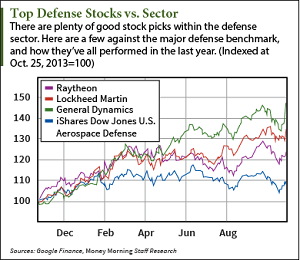Investors can choose from "nice-to-have" or "need-to-have" companies, but the latter is a stronger choice. Defense stocks are a perfect example.
 Defense companies will not disappear. Even U.S. government budget cuts won't entirely eliminate spending.
Defense companies will not disappear. Even U.S. government budget cuts won't entirely eliminate spending.
That's because, as Money Morning Chief Investment Strategist Keith Fitz-Gerald has said, "Right now there are 300 million people on the face of the earth who want to wipe out Western civilization."
United States President Barack Obama has said he is committed to degrading and destroying the Islamic State. But, the current U.S.-led bombing campaign is by many measures ineffective.
"USCENTCOM reports [it's] so small that it rarely totals even 25 strikes a day in both Iraq and Syria against a steadily more disperse Islamic State that can shelter in populated areas and use human shields without reservation," Anthony Cordesman, Arleigh A. Burke Chair in Strategy at the Center for Strategic and International Studies wrote in a report last week.
It's clear that without a more aggressive strategy, the talks of "degrading" - much less "destroying" - Islamic militarism is all bluster.
That's why defense companies will outlast many others - which is huge for investors...
Q3 Earnings for Defense Sector
There's no shortage of good buys in the sector, although one pick is a standout right now.
First, though, let's look at the sector's biggest third-quarter earnings reports.
General Dynamics Corp. (NYSE: GD) had a very productive Q3. Sales were up 3.3% from last year's $4.75 billion sales figure to $4.91 billion. GD's $2.06 earnings per share (EPS) bested last year's $1.84 by 11.7%.
Behind GD was the largest defense contractor Lockheed Martin Corp. (NYSE: LMT). LMT revenue fell 2.1% to $11.11 billion, but EPS grew 3.8% to $2.76.
Trailing behind the two was Raytheon Co. (NYSE: RTN). Sales fell 6.3% to $5.5 billion, and EPS was down 1.9% to $1.57.
These third-quarter figures make GD appear like the best defense pick - but that's not quite the case...
You see, there are obstacles ahead that some will handle better than others. Expected federal budget cuts provide a sizable headwind for defense contractors. The Feds are a steady source of income for all of them.
Congress' failure to find savings in the federal budget a few years back triggered cuts that hit defense in two ways over the next decade.
One of which is a $487 billion cut through the Budget Control Act of 2011. The other is a $500 billion cut as a part of "sequestration." Later negotiations did weaken those reductions. Defense got $22 billion more in 2014 and $9 billion more for 2015.
But budget uncertainty still remains and reductions are well beyond what the Department of Defense wants. This means defense contractors will need to find new customers to offset the domestic belt tightening.
And that would be a major shift for a couple of them...
The Defense Companies Best Equipped for Tight Budgets
As of the most recent reporting, U.S. government sales were 82% of LMT revenue, 17% was international customers, and 1% was commercial customers.
The same goes for GD. In 2013, the U.S. government made up 62% of sales, and another 18% was U.S. commercial sales. International business comprised 20%.
But for RTN, 27% of sales came from business abroad.
While it's true RTN relies heavily on the U.S. government, as 72% of its sales are from Uncle Sam, it's steadily grown revenues abroad in the last decade.
In 2004, international sales made up 18% of the revenue. RTN has grown that nine percentage points.
LMT and GD haven't made the same efforts to up their business operations abroad.
For GD, international sales have only grown three percentage points from 17% of sales, while at LMT it has remained virtually unchanged from its 16% of revenue a decade ago.
Combine RTN's international presence with the fact that it is trading at around $98, below GD's roughly $125 price tag, and LMT's about $175, and you have a winner.
It also is trading at a lower price-to-earnings ratio than the industry average. RTN's P/E is a reasonable 15.2, compared to the S&P 500's 18.4, and defense industry's 17.2. That bests GD's 17.5, and LMT's 18.1.
Sales may not have been impressive given the year-over-year decline, but there are two healthy points to focus on: RTN is committed to expanding internationally, and it's also positioned for longer-term sales growth. And while RTN has struggled to grow its revenue figures year over year, which it hasn't done since 2010, it is gearing up for a stream of lucrative projects.
RTN has a "sector-leading pipeline of international orders," reports The Wall Street Journal, and is continuing to bolster its relationships overseas.
Money Morning's Fitz-Gerald said RTN stands to gain from the United States' current "standoff" warfare military doctrine. He expects growth of 15% for the company in 2016.
This quarter, bookings - or expected contract orders - exceeded total sales at $5.9 billion. This will help drive long-term sales and reverse RTN's year-over-year losses, especially as the Feds catch on to what's at stake with tensions overseas.
"The bookings are coming in quite strong, both domestically and internationally," David Wajsgras, RTN's chief financial officer, said in the earnings call. "So over time, we see growth returning to Raytheon."
Also in Defense: This noted defense company is branching out, and will be a big profit opportunity in the "orbital junkyard"...
Related Articles:
- The Wall Street Journal: Raytheon Looks to Growth as Bookings Rise


